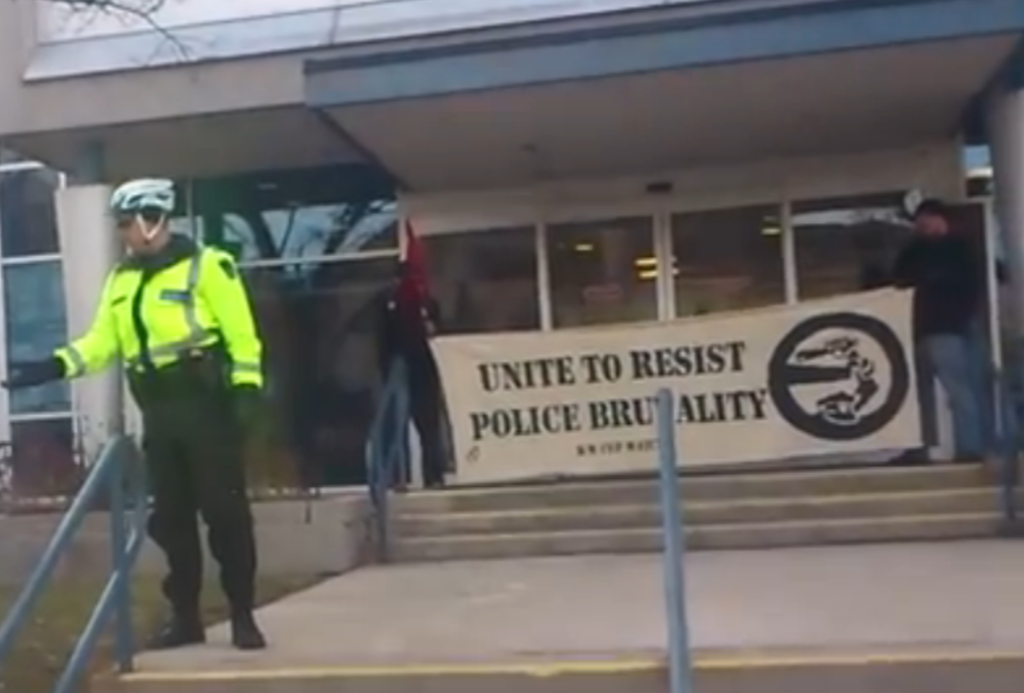November 2012 in Toronto there was an OIPRD conference on police complaints that put forward the Provincial Anti-Violence Intervention Strategy (PAVIS), the new model of policing. In response to this, KW Occupy, The Spot Collective, and Basics Community News Service interviewed 70 people from the East end and downtown of Kitchener to come up with our own understanding of policing and the PAVIS model.
Experience With Police
Several people mentioned good experiences with officers who have been kind and sympathetic, but this seemed to be the exception and more due to with the individual officers and not systematic policing practices. The most common experiences people had with police were being stopped and searched without being placed under arrest, being asked for their ID, being questioned without counsel present, or even before they have had their Rights read. Other less prevalent but still common experiences were the use of excessive force in arrests, being arrested on charges that are later dropped, having to stay in jail because of lack of bail, being targeted and pressured into giving information on friends or “people of interest”, and being denied basic rights while in custody.
Targeted Groups
Those who were targeted tended to be homeless people, marginalized communities and racial groups. Political activists are also targeted, especially if they belong to or are organizing one of those groups. There was heavy police presence in the downtown core, East end, Paulander etc.; places where there is higher unemployment, poverty, and immigration.
Increase of Police Violence
More and more police have been used to deal with people with mental health issues. Since they are not mental health workers and lack the training to do so this leads to escalations of violence. Police have also been increasing their use of force toward people whom they perceive as “troublemakers and undesirables” and those considered guilty by association such as friends or family.
Most dangerous is violence by proxy. For example, a native activist was arrested in plain sight, only to be released, given a business card, and told to contact the police with information on another activist, making it look to bystanders as if he was an informant. In another incident, police told activists and gang members that an article written about an informant was about them, leaving the writer open to violence. Police have also played gang members off each other, particularly by giving false information
Police Presence at Community Centers
More and more police are present in community centres and public spaces. Groups that receive public money are “encouraged” to be police friendly. Police in these spaces have asked about other activists, street people and minorities. While some see this as the police being nice, others are worried that police are using this as a way to gather information and intimidate. For example, during the conduction of several interviews for this report, police made their presence known. Another example is that CSIS, an intelligence agency, has advertised to recruit in an immigrant community space. Questions that police ask people when they “chat them up” are also revealing. By asking how is so and so doing, people feel that police are quietly building their friendship maps and keeping tabs on people.
Gentrification
There are less panhandlers downtown, but this has nothing to do with an improved economy. Instead, intensified police presence downtown has focused on the removal of undesirables to make it “more comfortable” for the economic group they are trying to attract. Businesses are quick to refuse service to those not “dressed nice enough”, even if they have money, and use police to remove them by force. Furthermore, people have noticed an increase in ticketing people of lower income as a deterrent for them to be downtown.
Accountability
Generally speaking, people feel that the police have the final say. Even when the court gives a verdict of not guilty, it does nothing to make up for the time spent in jail. People felt the police complaints process was useless, and of those interviewed, not one has had a complaint successfully resolved. Some felt that protests and the CopWatch program were one way of holding police accountable.
Police and Politics
The people saw the police as a political organization. Those interviewed felt that the police’s effect on grassroots politics is negative; activists were being arrested on charges later dropped, police are infiltrating activist groups and using informants to gather information on political meetings, activists and protests. Some felt that attending demonstrations made them targets, especially if they come from a poor or working class background or were racialized.
Tactics at Protests
Heavier police presence was noted at protests. People had their pictures taken and observed retaliation for attending such as getting picked up later on charges, being followed, or getting “jacked”. People have been told not to attend protests and felt intimidated from openly participating in political activity afterwards, especially if they came from a marginalized background. More interesting are the bail conditions those arrested have faced – they cannot associate with political people or legal democratic political groups, attend demonstrations, etc.
It is obvious to those interviewed that these conditions are aimed at stopping people from participating in political activity and has nothing to do with law and order. People have seen an increase in police attempts to recruit informers, infiltrate political organizations etc.
Comments
